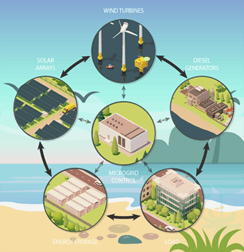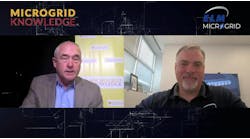Microgrids are much smaller scale than utility grids and, as a result, include components that are accordingly scaled down.
Here are the main components of a microgrid.
Electricity generation resources within microgrids
The beating heart of a microgrid consists of a set of electricity generation resources. Typical generation resources found in microgrids include diesel and/or natural gas generators, solar arrays and wind turbines.
The most basic microgrids are usually built around one or more diesel generators. When natural gas is available, gas generators are also among the options available. Older island microgrids, for example, are based on a small power plant consisting of a few diesel engines coupled to alternators. Generators are the default choice to power a microgrid because they can cover a wide range of loads and they can be used as backup power. They start quickly, are responsive to changes in load and can operate on a variety of fuels.
Fuel cell technology is emerging as a valid option to provide on-demand power for microgrids. Fuel cells can run on natural gas, hydrogen and other less common fuels. Although their cost remains too high to be widely used, hydrogen fuel cells are seen as a potential source of small-scale CO2-free electricity.
Intermittent energy resources within microgrids
The cost of solar panels has become so low that, in some regions, their installation on homes and businesses is a no-brainer. University campuses, industrial facilities and others equipped with a microgrid can install solar arrays in large numbers, thus achieving significant savings on their energy bills. In fact, many build a microgrid specifically to better integrate and take advantage of their solar resources.
Energy storage within microgrids
Many homeowners sometimes choose to supplement their home photovoltaic installation with a battery pack. Likewise, many microgrid owners incorporate battery energy storage in their system. With the price of lithium-ion batteries at an all-time low, the benefits of adding an energy storage resource often justify the additional cost.
For example, battery energy storage systems provide a service known as “time-shifting.” Time-shifting batteries collect extra electricity from an oversized solar system during the day and then discharge the battery after the sun has set to meet overnight load demands. Similarly, batteries can be discharged at times when the solar array output does not match the load requirements such as during short periods of peak demand. This allows the owner to maximize the use of intermittent resources.
Another benefit of battery systems is their ability to instantly respond to changes in electricity demand on the microgrid. Having a battery serve as standby capacity is often much more cost-effective than idling an extra generator 24/7 in case demand increases unexpectedly. Think of energy storage as the fat on the microgrid where energy is stored.
Load management within microgrids
Some microgrid owners have the option to actively manage electricity demand in the same way that they manage electricity generation.
By default, when a large electric machine starts up somewhere on the microgrid, the generators supplying the microgrid need to quickly ramp up to meet the additional demand. Microgrids that actively manage demand have another option. They can decrease demand somewhere else on the microgrid by, for example, switching off a building’s air conditioning temporarily. The result is that demand and generation are again balanced without increasing generation.
Control and communications within microgrids
Microgrids need a brain and a nervous system to operate safely and effectively, thus they require sophisticated microgrid control systems.
Wide-area utility grids serve millions of consumers and have a considerable amount of inertia, limiting the potential for fast, uncontrolled changes. Microgrids, in contrast, include fewer loads and resources and are more sensitive to variations in load and generation. Starting up several large electrical machines without the assurance that an equivalent amount of generation is available is a sure way to crash the microgrid.
A microgrid’s control system typically includes multiple controllers and sensors distributed over its territory. A supervisory control and data acquisition (SCADA) system is also required to collect data and distribute instructions.
If the SCADA system is the nervous system of the microgrid, then the energy management software is the brain and that software can be highly sophisticated. Artificial Intelligence and machine-learning features allow modern energy management software to better anticipate load from the consumers on the microgrid and generation from renewable assets to optimize the system to run in the most cost-effective way. Maximizing the use of renewable resources, minimizing fossil fuel costs and maintaining the reliability of the equipment and the microgrid, all while dispatching the load, is taken care of by the energy management software within the parameters specified by the owner of the microgrid.
Switchgears, inverters and other equipment
Finally, microgrids include other critical components such as electrical cables, circuit breakers, transformers and more. These components are the bones, muscles and blood vessels of a microgrid. They connect generation resources to consumers and allow the microgrid’s control system to effect changes to the state of the microgrid.
Automatic transfer switches, for instance, isolate different generation assets to ensure that, for example, the alternating current (AC) inverter associated with a solar array does not feed electricity to a diesel generator. Inverters convert the direct current power supplied by batteries or solar panels to AC power that is adequately synchronized to other AC resources on the microgrid.
To learn more about our microgrid solutions, visit https://www.cummins.com/generators/microgrids.









